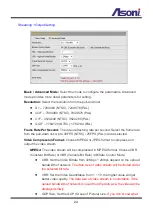
30
Static:
Assign IP address, subnet mask, gateway, and DNS manually.
Port Assignment
Set the ports if necessary. If this device will be connected via Internet, configure the
NAT (Network Address Translation) in router to match the port assignment.
HTTP Port:
Set the port for HTTP connection. The default is “80”, change the port if
you want to use router’s NAT (Network Address Translation) to make this device can
be linked from Internet.
RTSP Port:
Set the port for transfer the video and audio. The default is “554”, change
the port if you want to use router’s NAT (Network Address Translation) to make this
device can be linked from Internet.
RTP Port:
Set the port range of RTP port.
In RTSP mode, you may use TCP and UDP for connecting. TCP connection uses
RTSP Port. UDP connection uses RTP Start and End Port.
UPnP Setting
UPnP:
Enable or disable the UPnP protocol.
This device supports UPnP, if the UPnP service is enabled on your computer, the
device will automatically be detected and a new icon will be added to “My Network
Places”.
Note: UPnP service must be enabled on your computer.
The Windows Vista and Windows 7 have enabled UPnP service by default. To activate
UPnP service in Windows XP, please follow the procedure:
1. Open the “Control Panel” from the “Start” menu.
2. Select “Add/Remove Programs”.
3. Select “Add/Remove Windows Components” and open “Networking Services”
section.
4. Click “Details” and select “UPnP” to setup the service.
5. The network device icon will be added to “My Network Places”.
6. You may double-click the network device icon to access it via IE browser.
Multicast Setting
Multicast addressing is a network technology for the delivery of streaming to a group
of destinations simultaneously using the most efficient strategy to deliver the
messages over each link of the network only once, creating copies only when the links
to the multiple destinations split. To implement the Multicast, a switch or router that






























